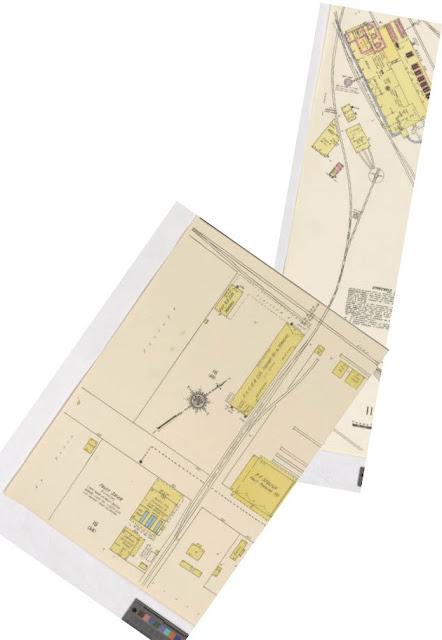The northern end of the PVCRR, Watsonville, was home to the original sugar beet factory and engine servicing facilities. By the 1920s, the sugar factory and engine house were gone. There was still a large freight house, used by both the Southern Pacific and the Pajaro Valley Consolidated RR (my prototype), as well as a turntable.
 |
| Watsonville, Ca, as it appeared on the 1908 Sanborn Insurance map |
As modeled in my basement, the railroad runs from the Spreckels Refinery north to Moss Landing. I had wanted to model the freight house and engine services in Watsonville, however, I ran out of space. In its place, I decided that a small bit of staging would suffice.
The prototype track arrangement was simple enough to duplicate, a mainline, a passing siding with a large freight house, and a turntable, made up the bulk of the trackwork as it appeared in the 1920s.
In planning my staging yard, I struggled to break away from the prototype layout (it worked then, it’d work now). Over the years, my designs ate up far too much space, always resulted in me wanting to add the structures and details to create a complete scene, and fluctuated from what actually existed in the 1920s (a turntable, no engine storage), and what would provide me with more operational tools (examples: engine storage tracks, a SP crossing). The only constant was that I never moved forward with the actual construction.
I finally decided that having something up was better than nothing, so I built a small layout extension (6” x 36”), and began placing track and turnout templates on it to see what would fit. In the end, I settled on three simple yard tracks. It isn’t prototypical, however it works, and I can always change it in the future. The biggest sacrifice was the turntable. For one, I couldn't find one I liked that fit my space, and more importantly, I accepted that I could just as easily use the wye at Moss Landing to turn trains and engines.
Until now, the layout ended at Moro Cojo Slough, which in reality, is much closer to the wye than the drawing below shows. This meant that there was only room for an engine and one car to turnaround. Now, not only can I store equipment for future operations, I can easily turn trains for their return trips to Spreckels on the other end of the layout.
Construction was simple, and the wiring was straight forward. I still need to finalize how I'll connect the staging yard to the layout, for now a clamp is in use. Otherwise, it's complete and doing exactly what I'd hoped.















Comments
Post a Comment